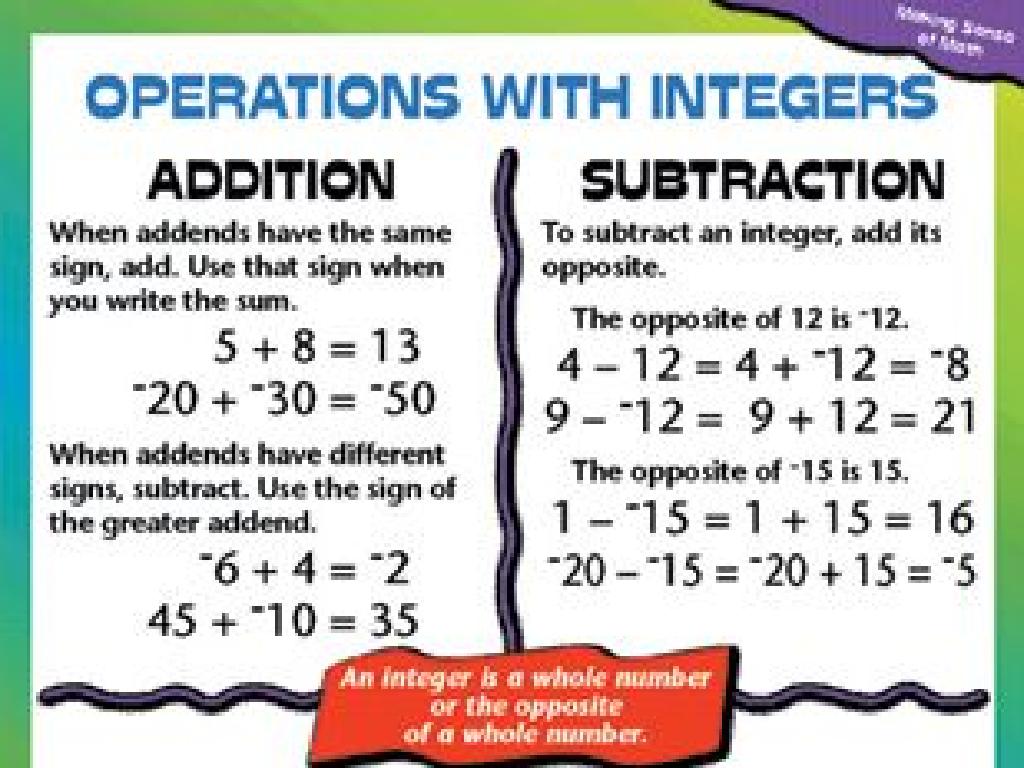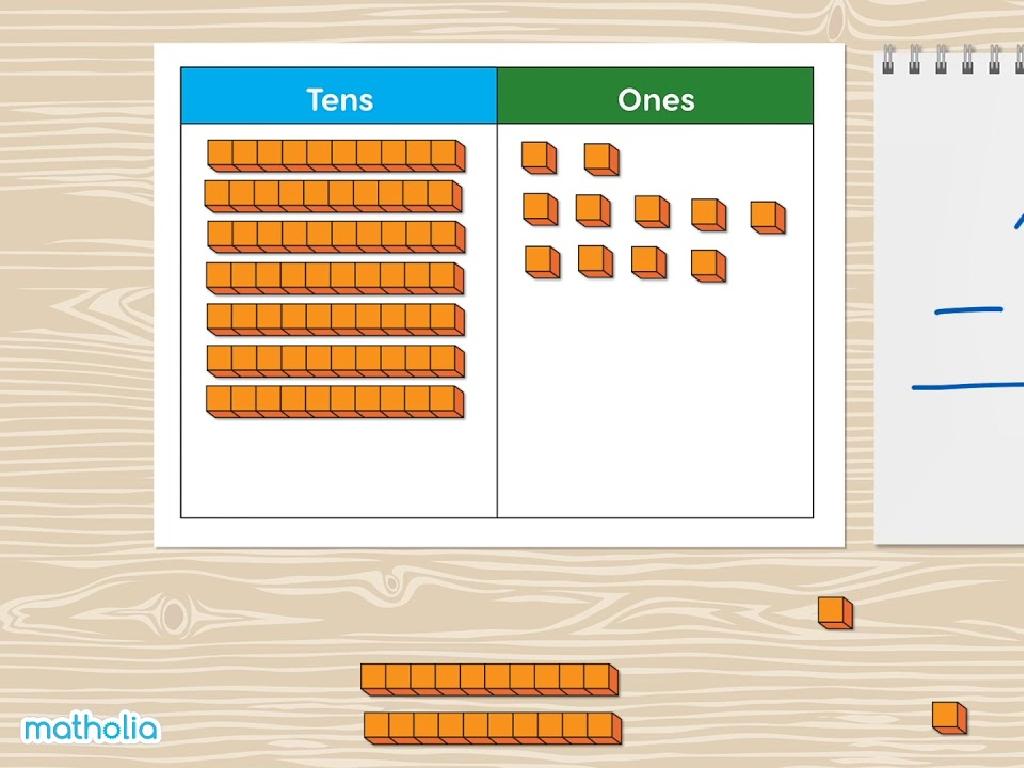Understand Quantity Supplied And Quantity Demanded
Subject: Social studies
Grade: Eighth grade
Topic: Supply And Demand
Please LOG IN to download the presentation. Access is available to registered users only.
View More Content
Introduction to Supply and Demand
– Explore market economy basics
– Define supply and demand
– Supply: quantity of goods available. Demand: consumer desire for goods.
– Examine their economic significance
– They determine prices and product availability.
– Analyze supply-demand relationship
– Interaction dictates market equilibrium and prices.
|
This slide introduces the foundational concepts of supply and demand within the context of a market economy. Begin by explaining a market economy as a system where decisions on production and consumption are based on supply and demand. Define supply as the amount of a product or service that is available to consumers, and demand as the desire of consumers to purchase goods and services. Emphasize the importance of supply and demand in determining the price of goods and services and in making economic decisions. Illustrate how the interaction between supply and demand creates a balance or market equilibrium, where the quantity supplied equals the quantity demanded at a certain price level. Use examples relevant to eighth graders, such as the supply and demand for a popular video game or sneakers, to make the concept more relatable.
Understanding Quantity Demanded
– Define Quantity Demanded
– The total amount of a good buyers are willing to purchase at a given price.
– Explore the Law of Demand
– As price decreases, quantity demanded increases, and vice versa.
– Factors influencing demand
– Price, income levels, tastes, and preferences can affect demand.
– Demand curve explanation
– Graphical representation showing the relationship between price and quantity demanded.
|
This slide introduces the concept of Quantity Demanded, a fundamental element in the study of economics and the market forces of supply and demand. Begin by defining Quantity Demanded as the specific amount of goods or services that consumers are willing to buy at a set price. Discuss the Law of Demand, which states that there is an inverse relationship between price and quantity demanded. Highlight factors such as consumer income, tastes, and price of related goods that can influence demand. Conclude with an explanation of the demand curve, which visually represents this relationship and sets the stage for understanding market equilibrium. Encourage students to think of examples from their daily lives where they’ve seen the Law of Demand in action.
Understanding Quantity Demanded
– Demand for a new video game
– High demand when a popular game releases
– Price changes and demand
– As price decreases, more people want to buy the game
– Interactive question on price effect
– If price increases, will demand increase or decrease?
– Predicting demand shifts
|
This slide aims to illustrate the concept of quantity demanded using the relatable example of a new video game release. Highlight how the initial high demand can lead to a surge in sales. Discuss how a decrease in price might make the game more accessible, thus increasing the quantity demanded. Conversely, an increase in price could lead to a decrease in demand. Use the interactive question to engage students in thinking critically about the relationship between price and demand. Encourage them to consider factors that might cause the demand curve to shift, such as changes in consumer preferences, income levels, or the release of a competing game.
Exploring Quantity Supplied
– Define Quantity Supplied
Quantity Supplied is the amount of goods producers are willing to sell at a given price.
– Understand the Law of Supply
As prices increase, producers are willing to supply more, and vice versa.
– Factors influencing supply
Cost of production, technology, and expectations affect how much producers supply.
– Graphical representation
|
This slide introduces the concept of Quantity Supplied within the broader topic of Supply and Demand. Begin by defining Quantity Supplied as the specific amount of goods that producers are willing and able to sell at a certain price. Then, discuss the Law of Supply, which states that there is a direct relationship between price and the quantity of goods supplied. Next, explore various factors that can influence the quantity supplied, such as production costs, technological advancements, and future expectations of the market. Lastly, illustrate these concepts with a supply curve on a graph, showing the relationship between price and quantity supplied. Encourage students to think of real-world examples where they have seen the law of supply in action.
Understanding Quantity Supplied: Smartphones
– Supply of smartphones example
– Smartphones are more supplied when demand is high.
– Production costs’ impact on supply
– Lower production costs can increase the supply.
– Interactive question on cost changes
– Predicting supply changes
– If costs decrease, would suppliers offer more smartphones?
|
This slide introduces the concept of quantity supplied using the real-world example of smartphone supply. Discuss how the number of smartphones a manufacturer is willing to supply can change based on consumer demand. Explain that production costs, including materials, labor, and technology, directly affect how many units are supplied. Lower costs typically enable suppliers to produce more. Engage the class with an interactive question about the effects of decreasing production costs on supply. Encourage students to think critically about the relationship between production costs and supply, and predict what might happen in different scenarios. This will help them grasp the dynamic nature of supply in the marketplace.
Equilibrium: Where Supply Meets Demand
– Define equilibrium in markets
– Equilibrium is when quantity supplied equals quantity demanded at a certain price.
– Explore market imbalances
– Imbalances occur when supply doesn’t equal demand, causing surpluses or shortages.
– Market adjustments
– Prices adjust to reach equilibrium, balancing the market.
– Equilibrium’s role in economy
|
This slide introduces the concept of equilibrium in the context of supply and demand, a fundamental concept in economics. Equilibrium occurs when the amount of goods supplied is equal to the amount demanded at a specific price point, known as the equilibrium price. When there’s too much supply or too much demand, the market is imbalanced, leading to either a surplus or a shortage. The market naturally adjusts to these imbalances through changes in price, which in turn affects supply and demand until equilibrium is restored. Understanding this concept is crucial for students as it forms the basis for much of economic theory and real-world applications. Encourage students to think of examples where they have seen prices change due to changes in supply or demand, such as seasonal products or trending items.
Class Activity: The Lemonade Stand Game
– Learn supply & demand through role-play
– Run your own lemonade stand
– Set prices & observe effects
– How does changing the price affect sales?
– Record quantity supplied & demanded
– Track how many glasses sold at various prices
|
This interactive class activity is designed to help students understand the concepts of quantity supplied and quantity demanded through a fun and engaging role-play game. Each student will simulate running their own lemonade stand, making decisions on pricing and observing the effects on demand. They will record the number of glasses of lemonade supplied and demanded at different price points to see the relationship between price, supply, and demand. Encourage students to think like business owners and economists, understanding the balance of setting a price that attracts customers but also covers costs. Possible variations of the activity could include factors like weather changes, competition, or advertising, to show how these can affect supply and demand.
Conclusion: Supply & Demand Essentials
– Recap of supply and demand
– Significance in economics
– Grasping these concepts is key to understanding market behavior and making informed decisions.
– Preview: Market Dynamics
– Explore how markets reach equilibrium and factors causing shifts.
– Upcoming: Price Fluctuations
– Learn how prices change with varying market conditions.
|
As we wrap up today’s lesson, it’s important to review the fundamental concepts of quantity supplied and quantity demanded that we’ve covered. Understanding these concepts is crucial for students as they form the basis of economic theory and are applicable in various real-world scenarios, such as determining prices of goods and services. Next class, we will delve into market dynamics, examining how supply and demand interact to create market equilibrium. We’ll also discuss how external factors can cause price fluctuations, affecting both consumers and producers. Encourage students to bring examples of price changes they have observed in their daily lives to the next class for discussion.






